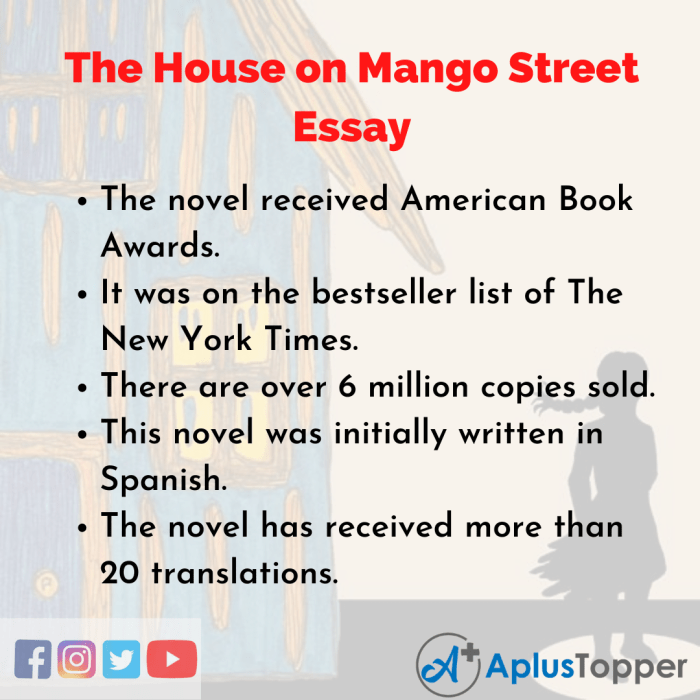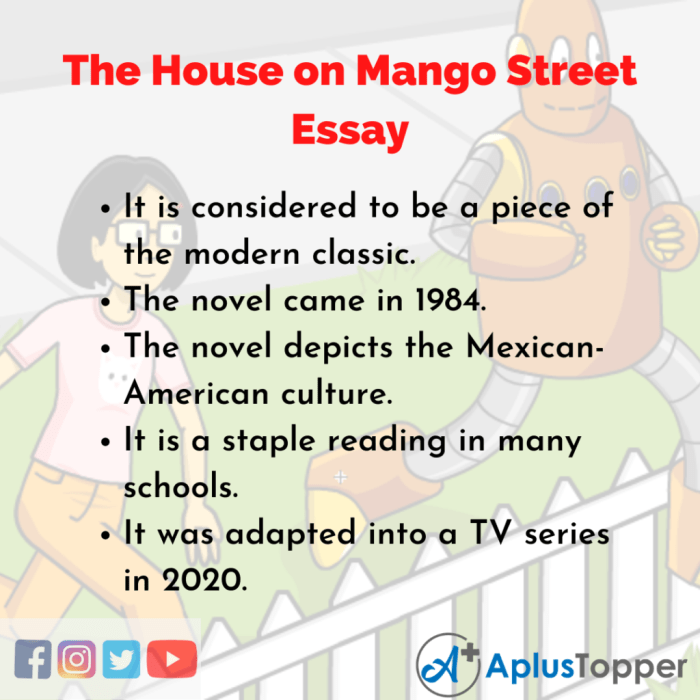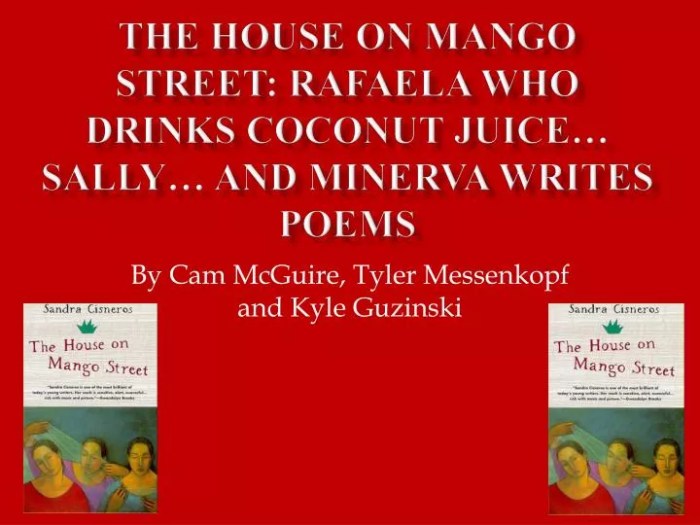Sandra Cisneros’s “Rafaela House on Mango Street” unveils a captivating tale of Rafaela, a young Latina girl navigating the complexities of her identity, family, and the immigrant experience. This poignant novel delves into the profound themes of home, belonging, and the enduring strength of the human spirit.
Throughout the novel, the titular house on Mango Street serves as a powerful symbol of Rafaela’s aspirations and the challenges she faces. Cisneros’s evocative writing style, characterized by vibrant imagery and poetic language, brings this story to life, leaving an unforgettable impact on readers.
Overview of “Rafaela House on Mango Street”

Rafaela House on Mango Streetis Sandra Cisneros’s debut novel, published in 1984. It is a semi-autobiographical work that tells the story of Esperanza Cordero, a young Latina girl growing up in a poor neighborhood in Chicago. The novel explores themes of identity, family, and the immigrant experience.
In Sandra Cisneros’ “The House on Mango Street,” Esperanza Cordero grapples with the challenges of growing up in a poor neighborhood. The novel explores themes of identity, family, and the search for a sense of belonging. For students studying this novel, the edmentum answer key english 1 can provide valuable insights into the text’s complex themes and characters.
Through its comprehensive explanations and analysis, the answer key helps readers delve deeper into the novel’s poignant portrayal of the human experience.
Rafaela House on Mango Streetis a significant work in Sandra Cisneros’s literary career. It was her first published novel and helped to establish her as a major voice in American literature. The novel has been praised for its lyrical prose, its vivid portrayal of the immigrant experience, and its honest exploration of the challenges faced by young women.
Themes of Identity, Family, and the Immigrant Experience
Rafaela House on Mango Streetexplores a range of themes, including identity, family, and the immigrant experience. Esperanza’s journey of self-discovery is a central theme of the novel. As she grows up, she struggles to find her place in a world that often seems hostile to her.
She is constantly trying to define herself, both as a Latina and as a woman.
Family is another important theme in the novel. Esperanza’s family is a source of both strength and support, but it is also a source of conflict. Esperanza’s parents are struggling to make ends meet, and they often take their frustrations out on their children.
Despite these challenges, Esperanza’s family is ultimately a source of love and belonging for her.
The immigrant experience is a third major theme in Rafaela House on Mango Street. Esperanza’s family is from Mexico, and they have come to the United States in search of a better life. However, they often face discrimination and prejudice. Esperanza’s experiences as an immigrant help her to understand the challenges faced by other immigrants, and she becomes a strong advocate for their rights.
Character Analysis of Rafaela

Rafaela, a central character in “Rafaela House on Mango Street,” stands out as a symbol of strength, resilience, and independence. Her indomitable spirit and determination to overcome life’s challenges make her a compelling and inspiring figure.Rafaela’s motivations are rooted in her desire for a better life.
Having escaped an abusive relationship, she seeks to create a safe and nurturing home for her children. Her strength and determination are evident in her ability to overcome adversity and provide for her family.
Rafaela’s Relationships
Rafaela’s relationships with other characters in the novel reveal her complex nature. She has a close bond with her children, whom she fiercely protects and loves unconditionally. However, she maintains a distant relationship with her husband, who is often absent and emotionally unavailable.Rafaela’s
relationship with Esperanza, the narrator, is significant. Esperanza admires Rafaela’s strength and independence, seeing her as a role model. Rafaela, in turn, provides Esperanza with guidance and support, encouraging her to pursue her dreams and overcome her own challenges.
Symbolism of the House on Mango Street

The house on Mango Street serves as a potent symbol of home, community, and identity for the protagonist, Esperanza Cordero. It represents the aspirations and struggles of the Mexican-American community in Chicago, and its changing state throughout the novel mirrors Esperanza’s own journey of self-discovery.
The House as a Representation of Home and Community
Initially, the house on Mango Street embodies the dream of a stable and loving home for Esperanza and her family. It is a place where they can escape the poverty and discrimination they face in the outside world. However, as the novel progresses, the house becomes a symbol of the limitations and frustrations of their lives.
The cramped quarters, lack of privacy, and constant noise reflect the challenges of living in a marginalized community.
Themes of Home and Belonging

The novel “The House on Mango Street” by Sandra Cisneros explores the importance of home and belonging, particularly for the protagonist, Esperanza Cordero. The novel highlights the struggle to find a sense of belonging in a neighborhood where the residents feel displaced and alienated.
Displacement and Alienation, Rafaela house on mango street
The novel depicts the protagonist’s experience of displacement and alienation within her neighborhood. Esperanza’s family moves frequently, which prevents her from establishing a stable sense of home. Additionally, she faces prejudice and discrimination from her neighbors due to her ethnicity and socioeconomic status, which further alienates her from her community.
Style and Language

Sandra Cisneros’s writing style in “Rafaela House on Mango Street” is characterized by its lyrical and evocative prose, as well as its use of imagery, metaphor, and symbolism. Her unique approach to language contributes to the novel’s vivid and impactful storytelling.
Imagery and Metaphor
Cisneros employs vivid imagery to create a sensory experience for readers, engaging their senses and immersing them in the world of Mango Street. She uses metaphors to draw connections between seemingly disparate elements, enhancing the novel’s emotional depth and resonance.
Symbolism
Symbolism plays a crucial role in “Rafaela House on Mango Street.” The house itself serves as a symbol of both hope and disappointment, reflecting the protagonist’s aspirations and the limitations she faces. Other symbols, such as the blue doors and the parrot, carry significant meaning and contribute to the novel’s overall themes.
Spanish and English
The novel’s use of both Spanish and English reflects the protagonist’s cultural identity as a Latina living in the United States. Cisneros’s incorporation of Spanish phrases and words allows readers to experience the protagonist’s linguistic world and gain insights into her cultural heritage.
General Inquiries: Rafaela House On Mango Street
What is the significance of the house on Mango Street?
The house on Mango Street represents Rafaela’s home and community, a place where she experiences both joy and hardship. It symbolizes her aspirations and the challenges she faces as an immigrant in a new country.
How does Rafaela’s character evolve throughout the novel?
Rafaela grows from a timid and insecure girl into a strong and independent young woman. She learns to embrace her identity and find her voice, despite the obstacles she encounters.
What are the major themes explored in “Rafaela House on Mango Street”?
The novel explores themes of identity, family, the immigrant experience, home, and belonging. It also delves into the challenges of growing up in a marginalized community.